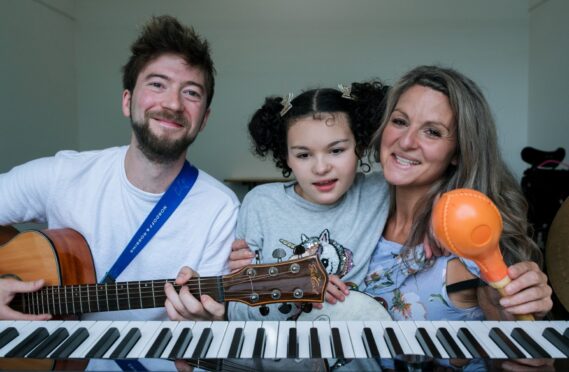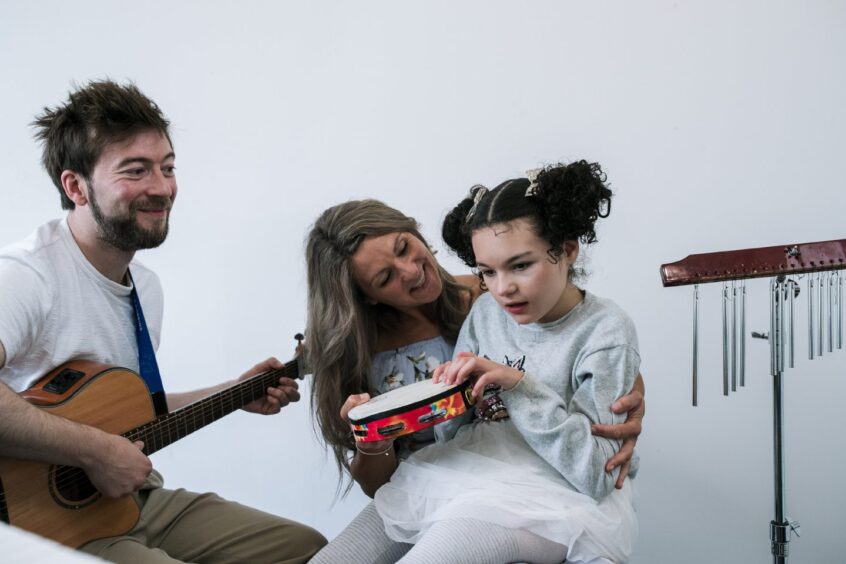
Where words fail, music speaks. This phrase has never been more true than for mum Steph Sanchez and daughter Kia, who have developed their own special way to communicate through sound and song.
Living with a range of complex needs and severe learning difficulties, 10-year-old Kia is unable to form words and sentences but, thanks to the transformative power of music therapy, she has finally found her voice as well as a deeper connection with her mum.
Working with the specialist team at Nordoff and Robbins, the UK’s largest music therapy charity, Kia has developed her “own musical language” which allows her to express feelings, emotions, wants and desires without the need for words – something which Steph says has been life-changing for the whole family.
“Kia has learned to express her feelings through vocalisations, music and playing instruments, and we’ve been taught to tune in to her and interpret the meaning,” explained Steph, from Lanarkshire.
“The opportunity for us to connect on a deeper level is just priceless – nothing else, no other therapy, has even come close to giving us this.
“It’s lovely to be able to communicate with her, and when you really tune in to the subtle nuances, she can express when she’s in pain, when she wants to play, when she’s sad and needs a cuddle, or even when she’s content being alone. It’s really made her empowered.
“In the adult world, we put so much emphasis on language and being able to use language but, actually, there are a lot of other forms of communication that we don’t give the credit or thought that we should.”
With its ability to enhance neuroplasticity, release dopamine for pleasure and motivation, reduce stress, improve connectivity between brain regions, and boost memory, attention and motor skills, music has the potential to help support people through everything from brain injury to dementia, mental health and even stroke recovery.
And, according to Karen Diamond from the British Association for Music Therapy, our understanding of music as a powerful universal language will only continue to grow.
“We are inherently rhythmic beings,” she explained. “We breathe in a rhythmic pattern. Our hearts beat in a rhythmic pattern. We even blink our eyes in rhythmic pattern. So, our inherent ability to respond to music and sound is no surprise.
“Music is something we actively seek as humans, and it is a valuable form of intervention for non-verbal people, who can express so much through music making. I’ve been practising music therapy for 34 years, and every day I’m still amazed by how music can impact someone. We’re still a relatively new, modern discipline, which means it’s constantly evolving, too.”
Offering the only music therapy course in Scotland, experts at Queen Margaret University are working on a range of exciting research projects to better understand music as a vital health intervention for people whose lives are affected by injury, illness or disability.
Lecturer Victoria Kammin says its use in paediatric palliative care is particularly interesting.
She added: “Research in music therapy is developing quickly in order to provide essential evidence for our practice. Music has a unique ability to unite people and foster communication and expression, and music therapists utilise this innate quality to help people express themselves and interact with others.”
Nordoff and Robbins has been a pioneer in music therapy for 60 years, and thanks to support from charity partners like Specsavers, which recently donated £50,000, more children like Kia – who has Epileptic Encephalopathy, Cerebral Visual Impairment, scoliosis and depends on a wheelchair – are getting the chance to express themselves and make new connections.
“Kia’s limited physical and communication capability means her world is very, very small,” said Steph, 42. “There’s very little she can take part in, and what few activities there are so expensive and often inaccessible.
“I could never have envisaged just how much joy musical communication would give her, particularly with other children in her school class who also don’t have language. They have musical conversations together now, and it’s just beautiful to watch.
“We sing to each other – or vocalise to each other – all day, every day, all the time. It has become part of our everyday life. Honestly, she’s rarely quiet now, so I’ve got a very noisy child!”
Music therapist Reuben Quinn, who works with Kia during weekly sessions, added: “For people like Kia whose communication is very limited, music provides the ability to experience changing other people with actions, in the moment, in real time.
“It’s about meeting her where she is, climbing into that bubble together, then expanding her sphere of experience through music.
“Music allows people to be vulnerable in a really safe way, and that applies to everyone from the beginning of their life right to the end.”
Steph added: “Kia just latched on to music therapy and she has become a much more communicative and expressive child which, subsequently, has made her so much happier. It’s a lovely addition to her life that I never would have thought was possible.”
Visit nordoff-robbins.org.uk

Enjoy the convenience of having The Sunday Post delivered as a digital ePaper straight to your smartphone, tablet or computer.
Subscribe for only £5.49 a month and enjoy all the benefits of the printed paper as a digital replica.
Subscribe © Andrew Cawley
© Andrew Cawley